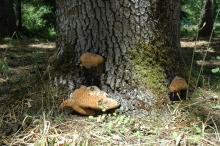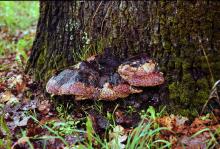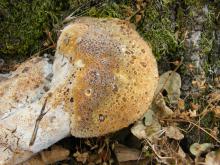See:
Oak (Quercus spp.) - White Pocket Rot (Piped Rot)
Cause Pseudoinonotus dryadeus (formerly Polyporus dryadeus), a common root and butt rot fungus on oaks, especially Oregon white oak in western Washington and Oregon. Presence of conks indicates decay, but the extent of decay is difficult to determine from external indicators alone because it often is localized in the tree. Decay in large roots and the lower bole may increase the failure potential of the tree.
Wood decay fungi enter trees primarily through wounds that expose sapwood or heartwood. Injuries from pruning, sunburn, lightning, or cultivating equipment can expose susceptible wood. Large wounds and stub and horizontal cuts are often entry sites for decay fungi. Mycelial growth of the fungus proceeds with colonization and utilization of wood as a food source. Live trees are able to limit wood decay by walling off and compartmentalizing decay fungi but this can vary between different species and individuals. The CODIT model/principle (compartmentalization of decay in trees) is used by certified arborists to manage landscape trees with decay.
Symptoms Sparse foliage with limb dieback may be symptomatic but these are not consistently associated with the disease. Wood decay is a white-mottled rot generally confined to the large roots and the base of the tree near ground level. Annual conks appear on the base of the tree or large roots at ground level in summer and early autumn. Conks are large (7 inches or more in diameter) and thick, tan to grey-brown on top with a pale-tan to grey underside (pore surface). The top surface of fresh conks has numerous droplets of clear-yellow liquid that darken with age. For this reason, it is sometimes referred to as the "weeping conk." The upper surface of conks weathers to black and deteriorates in winter to a dark-brown or black mass.
Cultural control
- Irrigation water, especially from sprinklers, should not wet the trunks.
- Mowing equipment should not injure the roots, crown, or lower trunk.
- Inspect trees for decay and/or conks to assess tree stability.
- Remove trees with extensive decay to avoid damage to surrounding property.
Reference Campbell, W.A., and Miller, J.H. 1952. Windthrow of root-rotted oak shade trees. Plant Disease Rep. 36:490. (Reference included because this short note is where the {inaccurate} idea of number and size of conks equates to amount of decay.)
Sinclair, W.A. and Lyon, H.H. 2005. Diseases of trees and shrubs, 2nd ed. Cornell University Press.




